Designed for ultra-slim notebook PCs and workstations, the Samsung SM951-NVMe is the industry’s first M.2 NVMe PCIe to hit the market. Samsung has been offering an AHCI-based PCIe 3.0 version of its SM951 line for several months now. With this new highly-anticipated NVMe edition, Samsung is adding a powerful and welcomed drive to its quality SSD portfolio all the while reinforcing its dominance in the flash memory market. Samsung also has indicated that it will be incorporating its 3D V-NAND technology into the SM951-NVMe sometime in the future, which will further increase the drive’s density as well as help it to boast even better performance.
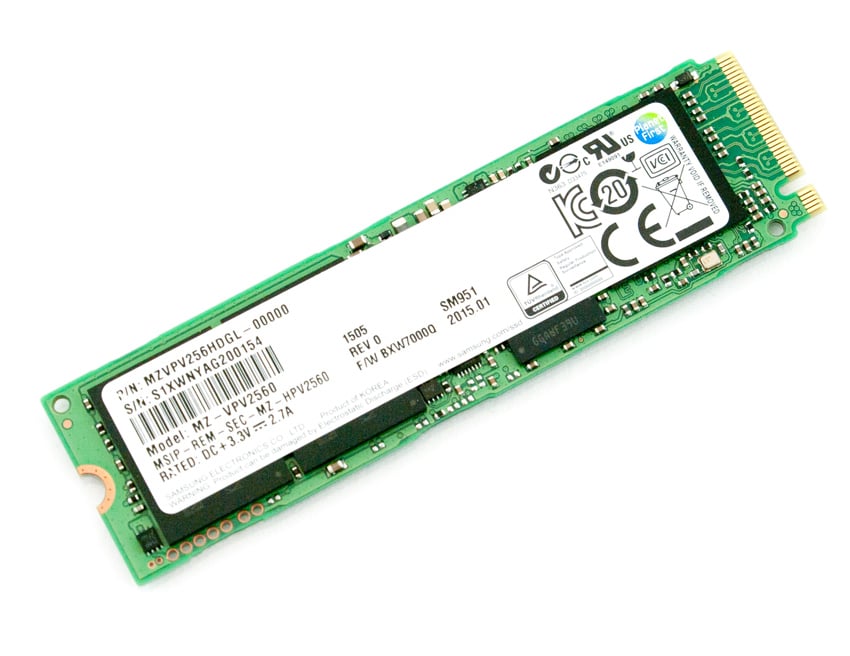
Because Samsung’s new drive uses the NVMe protocol, it brings various performance improvements. As such, looking at its potential performance, the new SM951-NVMe is quoted to reach sequential data read and write speeds up to 2,260MB/s and 1,600MB/s, respectively. These figures are slightly better than the PCIe 3.0 version, which touted a maximum of 2,150MB/s read and 1,500MB/s read for the 512GB model. Looking at its random read operations specifications, Samsung indicates that the SM951-NVMe can process 300,000 IOPS, which is more than twice the speed of the 130,000 IOPS rate of the PCIe version. Both models are equipped with Samsung’s UBX 3-Core controller technology. Even though SM951-NVMe packs a huge haymaker in the performance column, the drive’s thickness is roughly 3.73 millimeters when equipping chips on both sides of the board and weighs less than 7 grams. This tiny SSD will likely be a huge boost in performance in any scenario for anyone looking to upgrade their ultra-slim notebooks or PCs with an M.2 slot.
Like its AHCI-based equivalent, the SM951-NVMe uses the L1.2 low-power standby mode, allowing all high-speed circuits to be turned off when the host computer is in sleep mode or in hibernation. As a result, the overall power consumption SM951-NVMe is significantly reduced to under 2mW.
The Samsung SM951-NVMe comes in capacities of 512GB, 256GB, and 128GB. We will be looking at the 256GB unit for this review.
Samsung SM951-NVMe M.2 SSD Specifications
- Capacities: 128GB (MZVP128HDGM), 256GB (MZVPV256HDGL), 512GB (MZVP512HDGL)
- Form Factor: M.2
- Interface: PCIe Gen3 8Gb/s x4
- Bytes per Sector: 512 Bytes
- Seq. Read:
- 256/512GB – Up to 2,150MB/s
- 128GB – Up to 2,000MB/s
- Seq Write:
- 512GB – Up to 1,550MB/s
- 256GB – Up to 1,260MB/s
- 128GB – Up to 650MB/s
- Random Read: Up to 300K IOPS (All capacities)
- Random Write:
- 256GB/512GB – Up to 100K IOPS
- 128GB – Up to 83K IOPS
- Reliability:
- UBER: < 1 sector per 1015 bits read
- MTBF: 1.5 Million Hours
- Features
- PCIe Gen3 8Gb/s Interface up to 4 lanes
- Compliant with PCIe Base Specification Rev.3.0
- Compliant with NVMe Express Specification Rev.1.1a
- Power Saving Modes:
- Supporting APST
- Supporting L1.2 Mode
- Support Admin and NVM Command Set
- End-to-End Data Protection
- RoHS Compliant
- Support up to 1 Namespaces
- Support up to 8 I/O Queues
- Support up to 16K Queue entries for each I/I Queue
Design and build
Samsung SM951-NVMe M.2 SSD is much smaller 2.5 inch SSD and offers a thickness of under 4mm. It looks virtually identical to its brethren, lacking any casing, which leaves its components exposed and vulnerable to damage. As a result, users must take care in transporting the device.
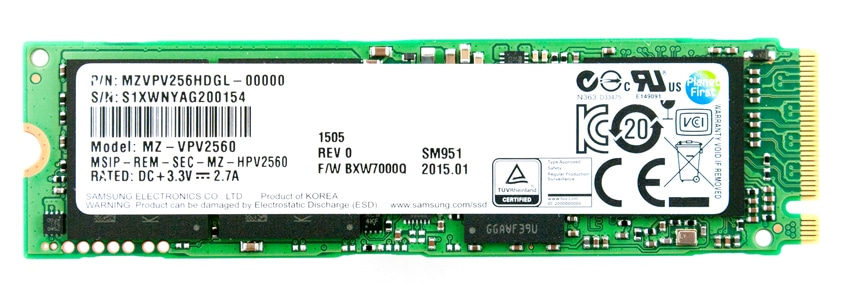
The front side of the drive comes with a sticker, which partially covers the NAND chips. This displays various information pertaining to the drive, including the model number and certifications. The side opposite of the connectors sports an M key notch to denote PCIe x4 and SATA compatibility. All capacities use the Samsung UBX 3-Core controller and Samsung 16nm MLC NAND.
Consumer Synthetic Benchmarks
All consumer SSD benchmarks are conducted with the StorageReview HP Z620 Workstation.
We will be comparing the Samsung SM951-NVMe to the following drives in this review:
In our first test, we measured 2MB sequential performance from Samsung SM951-NVMe, which posted an impressive 1,820.4MB/s read and 1,191.9MB/s write. While the drive had better read activity compared to the PCIe model, it did record weaker write performance.
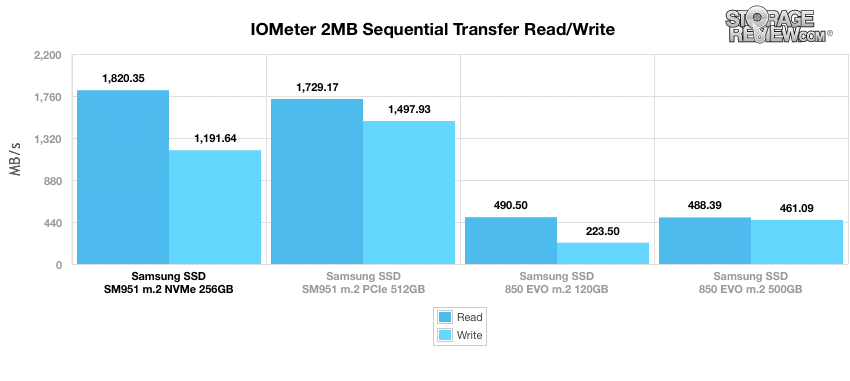
When looking at 2MB random transfer performance, the Samsung SM951-NVMe again recorded impressive with read and write activity that measured 1,417.9MB/s and 1,076.1MB/s, respectively. The PCIe model measured 1,337.6MB/s read and 1,080.9MB/s and write.
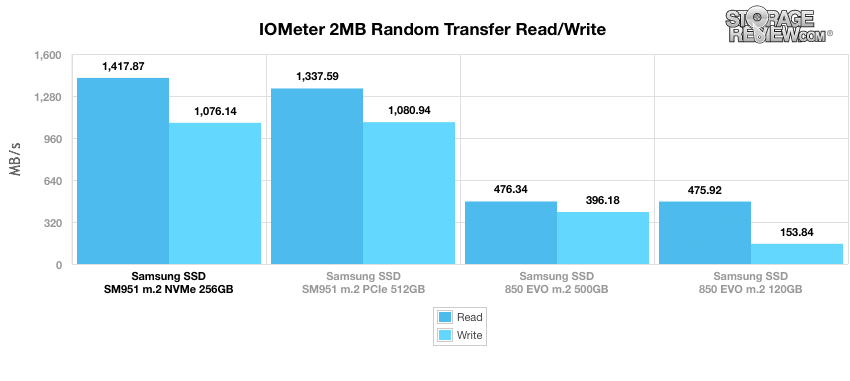
Moving to smaller 4k random transfers (throughput workload), the Samsung SM951-NVMe measured a whopping 13,497.5 IOPS read and 44,510.5 IOPS write easily beating its PCIe brethren, which posted 9,800.2 IOPS for read activity and 34,836.6 IOPS for write activity.
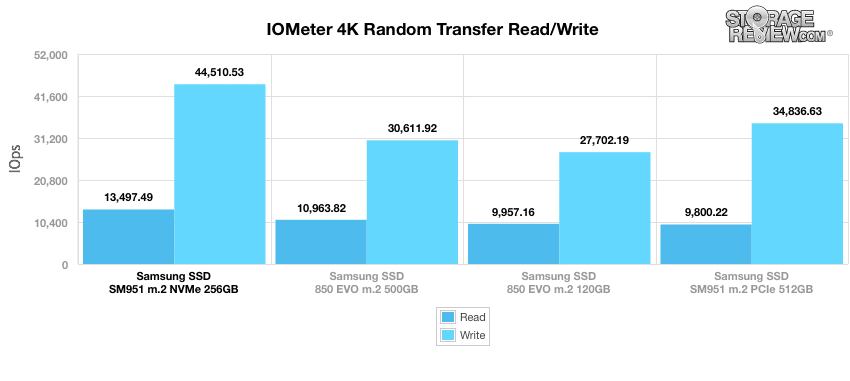
Our next benchmark measured the Samsung SM951 drives in MB/s using the same file size. Here, the Samsung SM951-NVMe boasted read and write performance of 52.72MB/s and 173.87MB/s, respectively, easily taking top spot in both columns. Its PCIe counterpart recorded 38.28MB/s read and 136.08MB/s write.
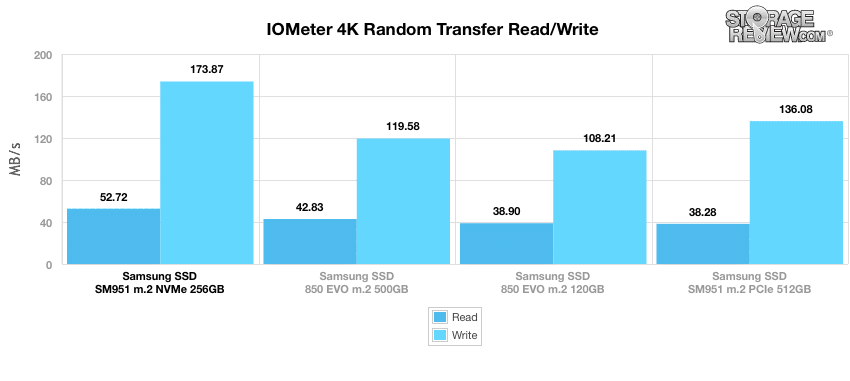
When looking at average write latency, the SM951-NVMe continued its dominance with an impressive average response time and peak latency at 0.0221ms and 0.5787ms, respectively.
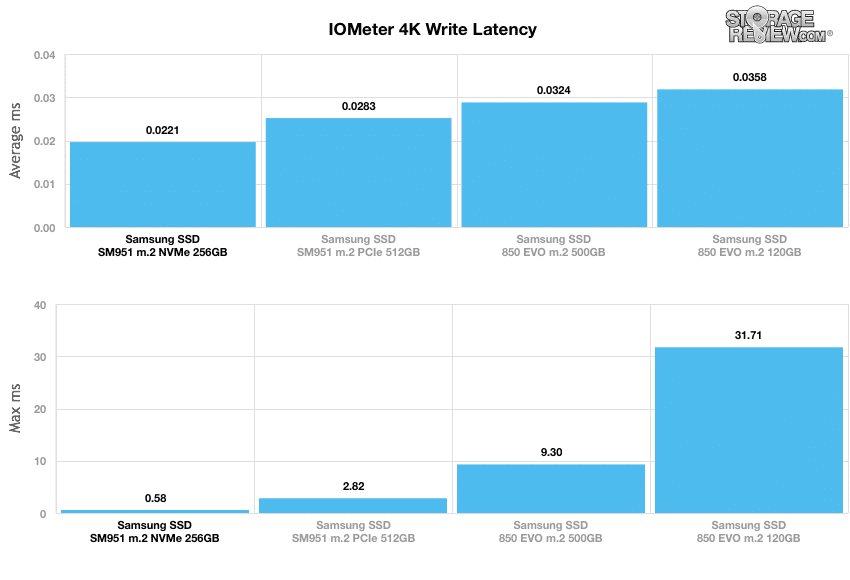
In our next test, we shifted to a 4K random workload with 100% write activity that scales from 1QD to 64QD. Here, the Samsung SM951-NVMe scaled from 44,899.38 IOPS to an impressive 92,690.58 IOPS. This was nearly 20,000 more throughput than the PCIe model.
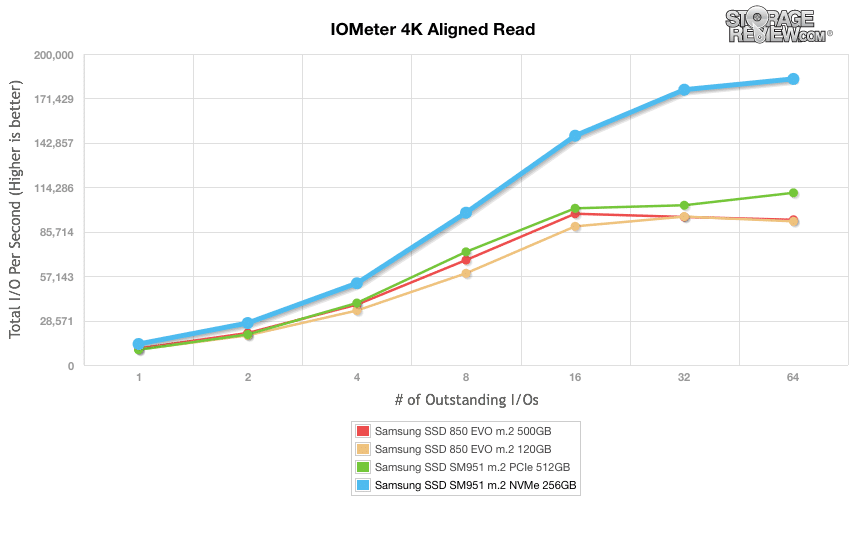
Moving to read activity, we measured SM951-NVMe with a range of 13,492.97 IOPS at QD1 while peaking at an incredible 183,971.64 IOPS in the terminal queue depths.
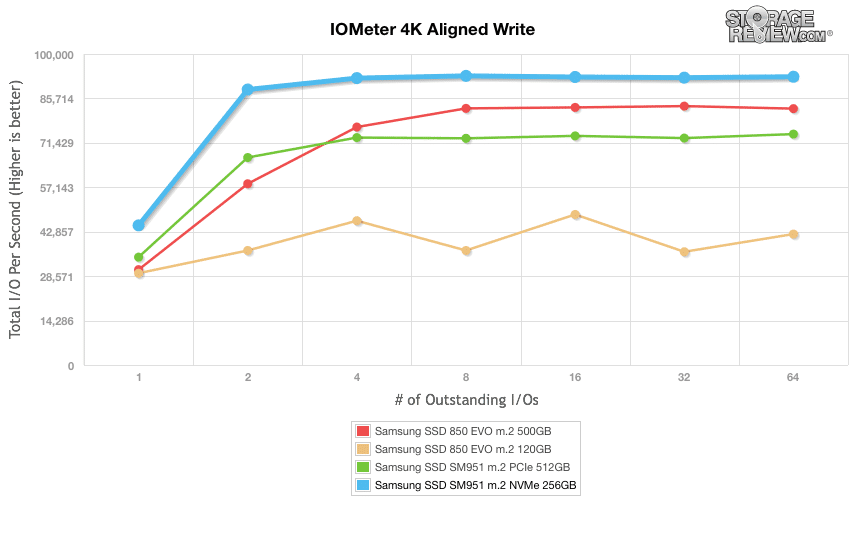
Our last series of synthetic benchmarks compare the hard drives in a series of server mixed-workloads with a queue depth of ranging from 1 to 128. Each of our server profile tests has a strong preference towards read activity, ranging from 67% read with our database profile to 100% read in our web server profile.
The first is our database profile, which consists of a 67% read and 33% write workload mix primarily centered on 8K transfer sizes. In this trace, we recorded the Samsung-NVMe with a range of 10,818.31 IOPS to an impressive 108,711.27 IOPS in the terminal queue depths, which was over 30,000 IOPS more than the PCIe version.
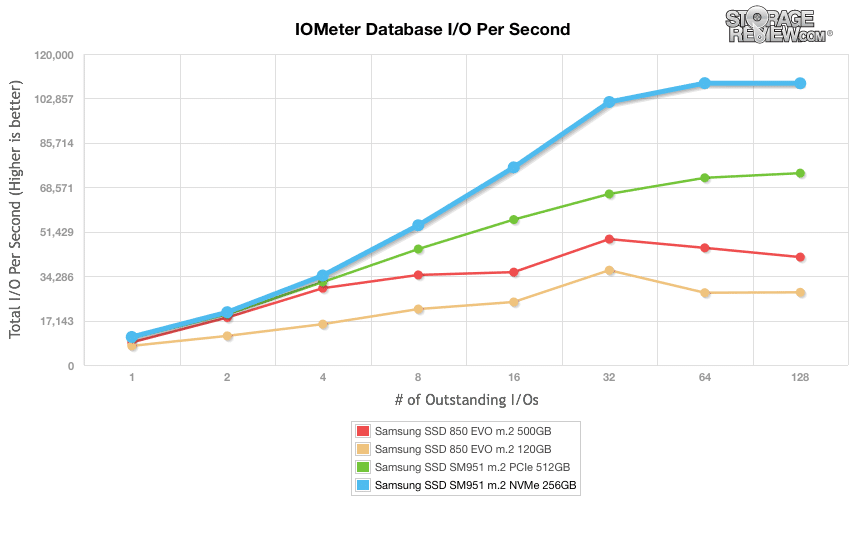
The next profile looks at a webserver, with 80% read and 20% write workload spread out over multiple transfer sizes ranging from 512-byte to 64KB. Here, the Samsung SM951-NVMe had an initial throughput of 9,802.45 IOPS and 93,649.20 IOPS in 128QD once again dominating the leaderboard with impressive results.
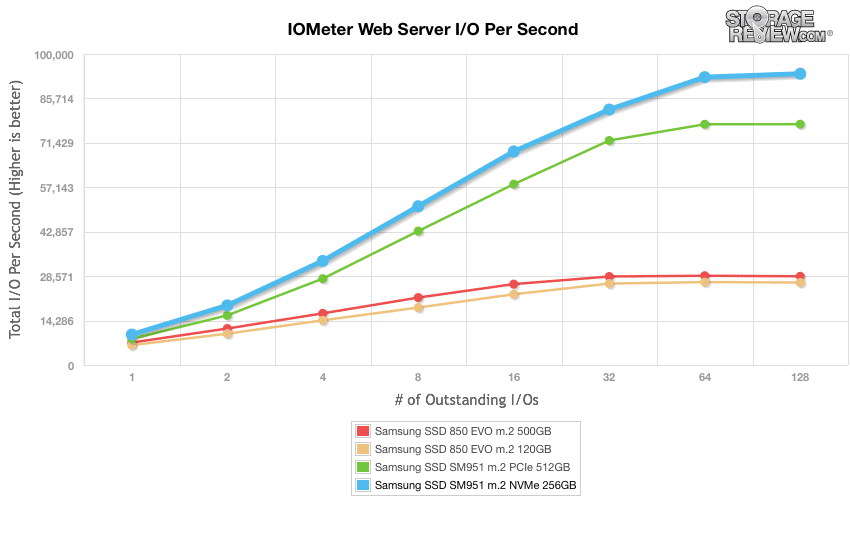
Our file server profile is read-only with a spread of transfer sizes from 512-byte to 512KB. The Samsung NVMe drive continued it impressive performance while recording a QD1 of 10,224.05 IOPS and a QD128 of 83,059.73 IOPS.
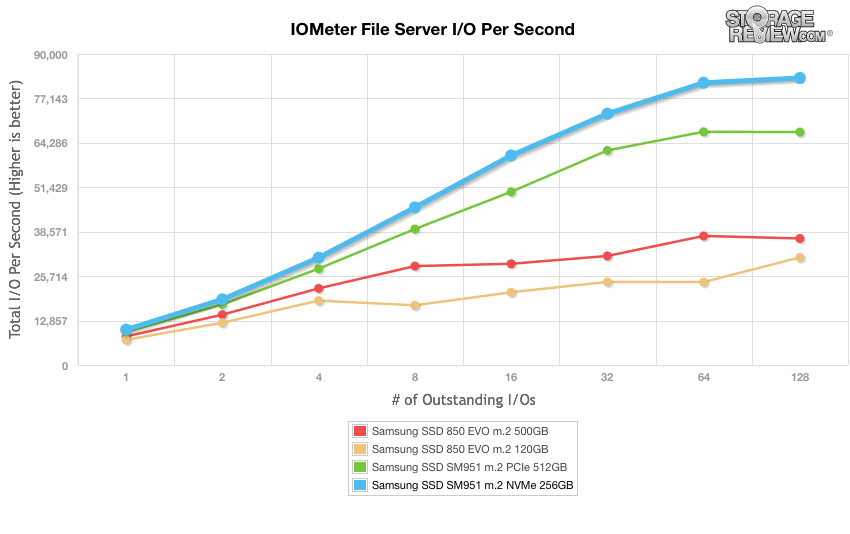
The last profile looks at workstation activity, with a 20% write and 80% read mixture using 8K transfers. In this scenario, the SM951-NVMe unsurprisingly offered a dominating range 10,242.97 IOPS to 118,275.84 IOPS.
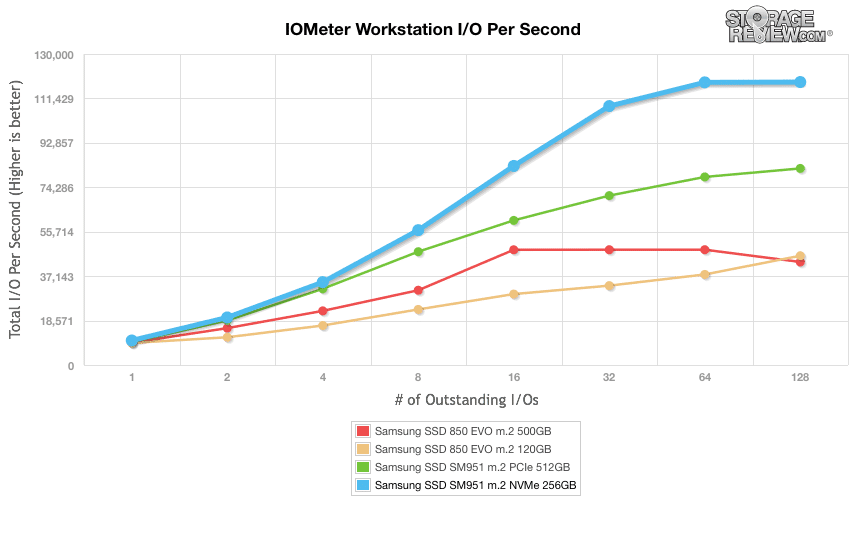
Consumer Real-World Benchmarks
For the average consumer, trying to translate random 4K write speeds into an everyday situation is pretty difficult. It helps when comparing drives in every setting possible, but it doesn’t exactly work out into faster everyday usage or better game loading times. For this reason we turned to our StorageMark 2010 traces, which include HTPC, Productivity, and Gaming traces to help readers find out how a drive might rank under these conditions.
The first real-life test is our HTPC scenario. In this test we include: playing one 720P HD movie in Media Player Classic, one 480P SD movie playing in VLC, three movies downloading simultaneously through iTunes, and one 1080i HDTV stream being recorded through Windows Media Center over a 15 minute period. Higher IOps and MB/s rates with lower latency times are preferred. In this trace we recorded 2,986MB being written to the drive and 1,924MB being read.
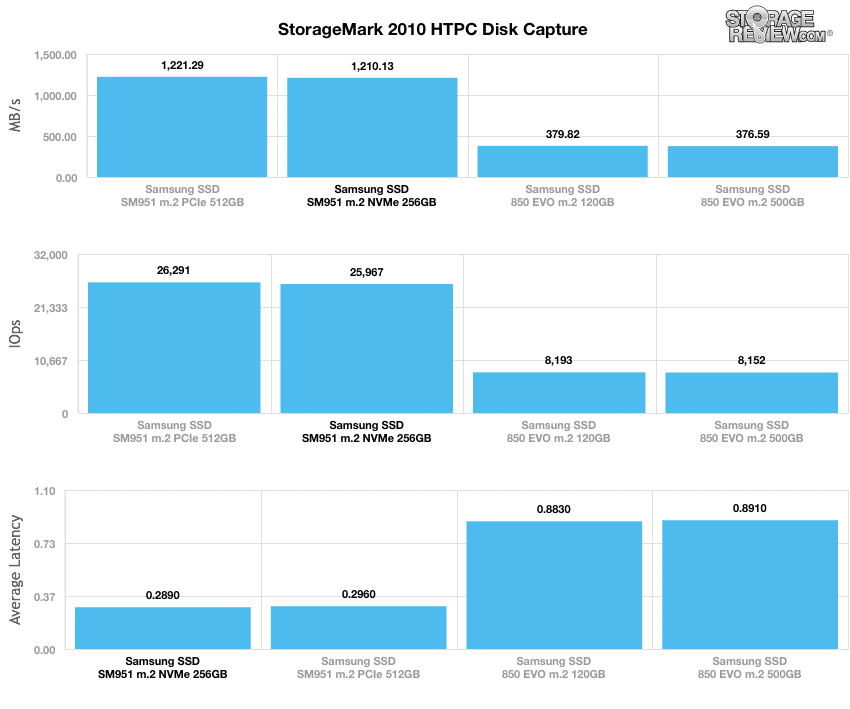
In our HTPC profile, the SM951-NVMe posted a blistering average speed of 1,210.13MB/s, 26,291 IOPS and 0.296ms in average latency; however, the PCIe version of the SM951 boasted slightly better numbers.
Our second real-life test covers disk activity in a productivity scenario. For all intents and purposes, this test shows drive performance under normal daily activity for most users. This test includes: a three hour period operating in an office productivity environment with 32-bit Vista running Outlook 2007 connected to an Exchange server, web browsing using Chrome and IE8, editing files within Office 2007, viewing PDFs in Adobe Reader, and an hour of local music playback with two hours of additional online music via Pandora. In this trace we recorded 4,830MB being written to the drive and 2,758MB being read.
In our Productivity trace, SM951-NVMe posted results slightly under its PCIe brethren once again, with 29,131.29 IOPS, 920.66MB/s, and 0.258ms in average latency.
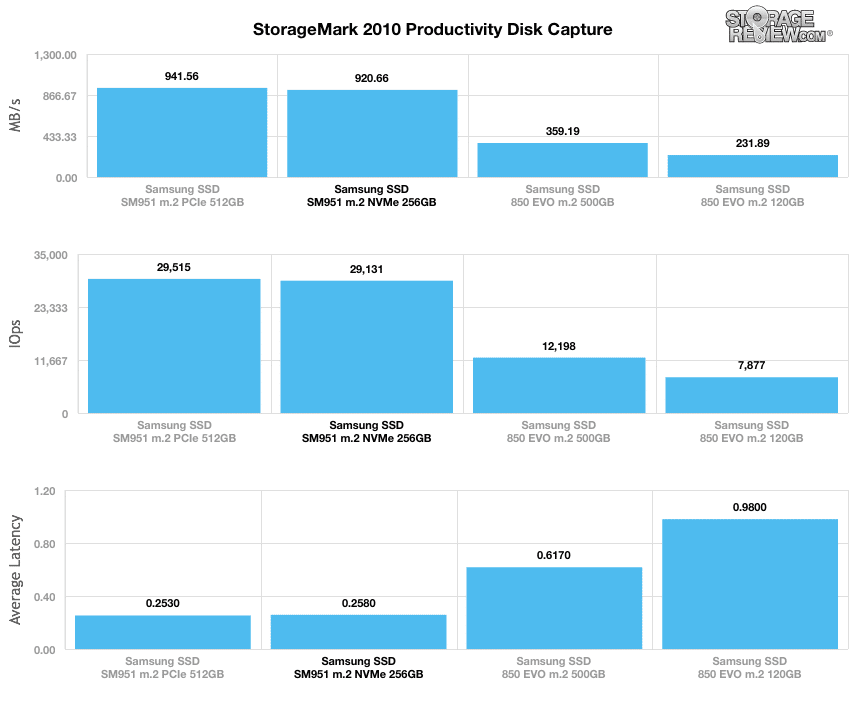
Our third real-life test covers disk activity in a gaming environment. Unlike the HTPC or Productivity trace, this one relies heavily on the read performance of a drive. To give a simple breakdown of read/write percentages, the HTPC test is 64% write, 36% read, the Productivity test is 59% write and 41% read, while the gaming trace is 6% write and 94% read. The test consists of a Windows 7 Ultimate 64-bit system pre-configured with Steam, with Grand Theft Auto 4, Left 4 Dead 2, and Mass Effect 2 already downloaded and installed. The trace captures the heavy read activity of each game loading from the start, as well as textures as the game progresses. In this trace we recorded 426MB being written to the drive and 7,235MB being read.
In our read-intensive Gaming trace, the Samsung SM951-NVMe boasted an impressive 1,443.14MB/s, 29,652.25 IOPS, and an average latency of only 0.208ms, the latter which was better than the PCIe version.
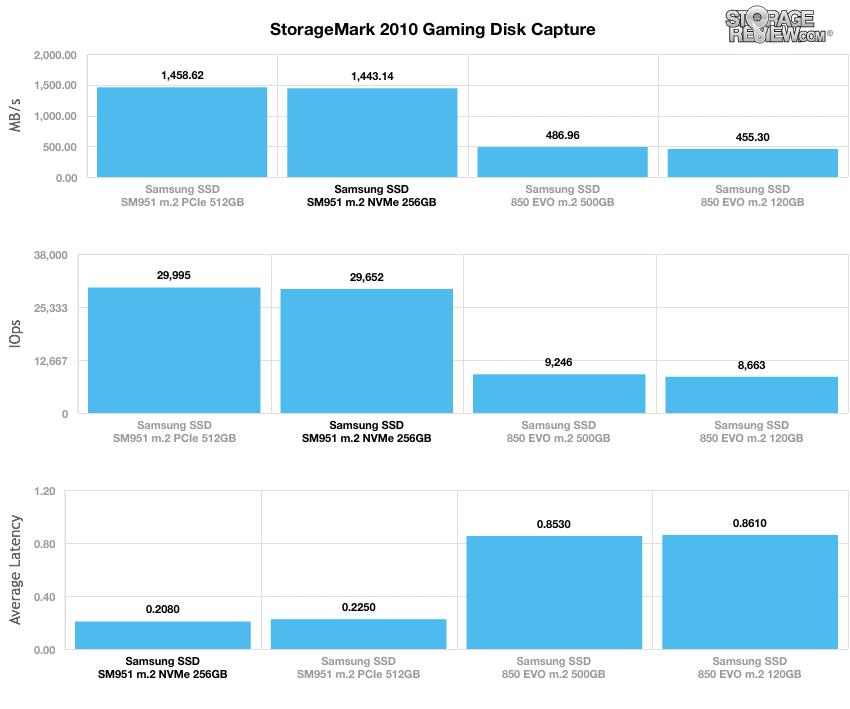
Conclusion
The highly anticipated Samsung SM951-NVMe M.2 PCIe SSD is quite a remarkable drive, impressing us with some pretty incredible throughput during our benchmarking tests. The drive is itself comes in capacities up to 512GB; however, like the PCIe model, we would have liked to see Samsung offer a 1TB model on top of the available capacities. Under the hood, the SM951-NVMe is equipped 16nm NAND as well as the same Samsung UBX 3-Core controller as its brethren. This hardware is neatly stored inside a tiny M.2 form factor that weighs less than seven grams, allowing enthusiasts to upgrade their compatible ultra-slim notebooks in a pretty substantial way. Samsung also designed the SM951-NVMe with the L1.2 low-power, extremely power efficient standby mode, which allows all of its high-speed circuits to be turned off when the host computer is in sleep mode or in hibernation.
When diving into its performance, the SM951-NVMe posted tremendous results overall, which was highlighted by our consumer synthetic benchmarks. To summarize, our 2MB sequential transfer test showed the SM951-NVMe with a top-in-class 1,820.4MB/s read and 1,191.9MB/s write, while our random workload recorded read and write activity at 1,417.9MB/s and 1,076.1MB/s, respectively. Moving to our smaller 4k random transfer benchmarks at QD1, the Samsung SM951 posted an incredible 13,497.5 IOPS read and 44,510.5 IOPS write, which easily beat out its comparables. The disparity between the two SM951 models really showed during our server mixed-workloads (with a queue depth of ranging from 1 to 128), where the SM951-NVMe recorded speeds that were by far the fastest we’ve seen for a consumer drive, beating out all of the other drives by a significant margin. Things slowed down a bit once we put it through our real-world benchmarks, however, with the PCIe version actually having slightly better results in all of our workloads with the exception of latency during our gaming trace. Nevertheless, the numbers we measured from the NVMe drive during the real-world tests were still incredibly impressive.
Because Windows 8.1 has built-in NVMe support, getting the SM951 up and running was a seamless process even though Samsung doesn’t offer any specific driver support; we simply connected the drive and it was ready to test. However, things might be a bit more complicated when using previous versions of Windows operating systems. Overall, this drive certainly has a lot to offer and is undoubtedly one of the fastest M.2 drives the industry has to offer; however, this performance comes at a premium price. That being said, because there is a very limited selection of M.2 options on the SSD market (especially remarkably high-performing ones like the SM951-NVMe), a lot of power users will find this release very exciting, with StorageReview being among them.
Pros
- NVMe interface allows for incredible performance
- Small form factor
- Low power consumption
Cons
- Top capacity is only 512GB
The Bottom Line
The Samsung SM951-NVMe is a very powerful M.2 SSD that will be attractive to OEMs looking to build high-performance laptops and workstations.
Samsung SSDs at AmazonDiscuss this review




 Amazon
Amazon